“Eric Aho: Guide” at DC Moore in New York consists of about a dozen canvases invested with painterly meditations on the idea of a forest. The emphasis here is on the idea, for the smaller canvases that comprise half the show appear to be abstract estimates of enclosed spaces surrounded by trees, while the remaining and dramatically larger paintings offer silhouettes of forest elevations, vaguely articulated but for unambiguously rendered treetops near each painting’s upper edge. Suggestions of form are reduced to quick painterly gestures.
Hints of figures abound but prove nearly impossible to verify. The location of the man referenced in Man with an Axe is a challenge, with his presence remaining a claim in the title. Yet there is a feeling of something there in almost every painting. Light from the sky comes through small spaces between treetops, as do hints of vistas revealing distant hills and clouds.
.
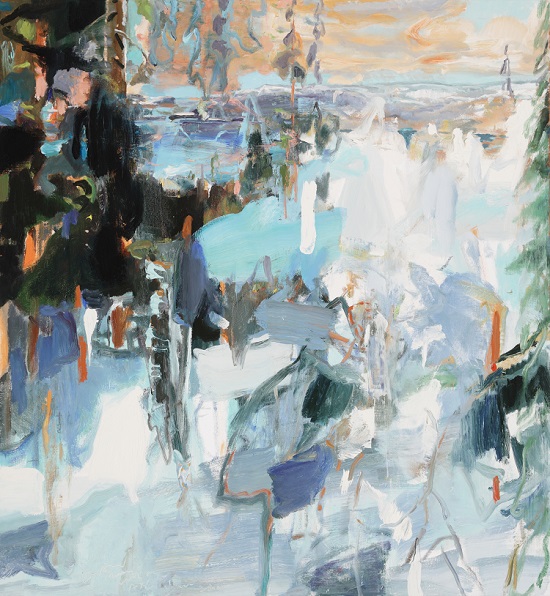
"Man with an Axe" by Eric Aho, 2018. Oil on linen, 52 x 48 inches. Courtesy of the artist and DC Moore Gallery, New York.
.
These sky openings tend to be fractions of the painting’s total surface, yet they influence one’s interpretation of each piece’s total chromatic feel. The mural-size Guide, 2018, for example, relies on an intense triangle of late evening glow—an uncanny mix of yellows and greens reminiscent of Rockwell Kent—that lends an associative vibrancy to the somber blacks and greys below it.
.
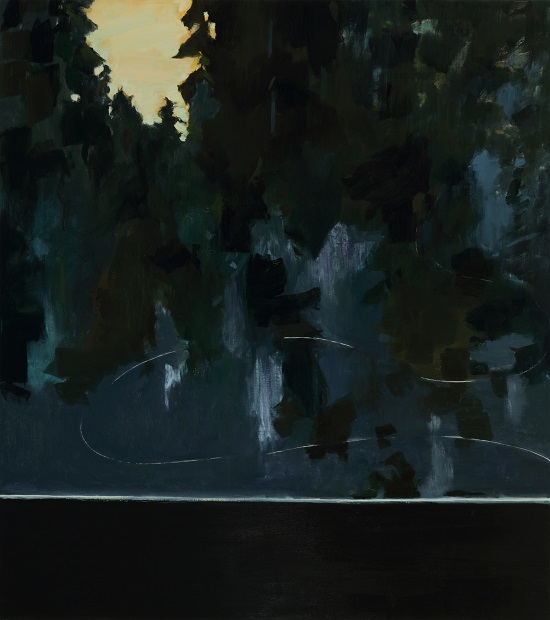
"Guide" by Eric Aho, 2018. Oil on linen, 90 x 80 inches. Courtesy of the artist and DC Moore Gallery, New York.
.
Aside from color dynamics, there is what seems an intentional interaction between each painting’s implied observation point and the size of the canvas used. The 8-foot height of Meadow mimics and amplifies the atmospheric distance between viewers and the forest rising before them, while Hunter indicates an intimate proximity to specific yet barely discernible items: leaves on the ground, perhaps a tent. The ensuing compression of space and the reduction of detail to broad strokes focuses attention on the gesture itself and less on what it strives to depict.
.
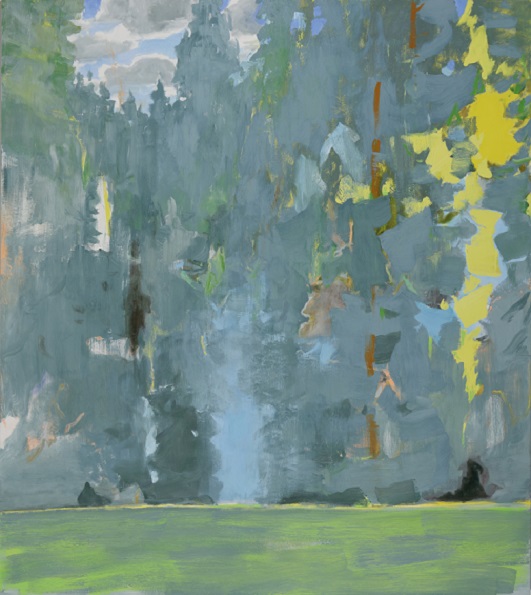
"Meadow" by Eric Aho, 2018. Oil on linen, 90 x 80 inches. Courtesy of the artist and DC Moore Gallery, New York.
.
In the painting titled Source, one can decipher a waterfall in the upper section, while the lower region falls to groundless floating abstraction. As a pattern repeated in each canvas, its effect on the viewer is the same. In both cases, one senses a note of caution regarding an unwelcoming environment. Nature either appears as a wall obstructing open space, or an environment of confusion and disorientation.
.
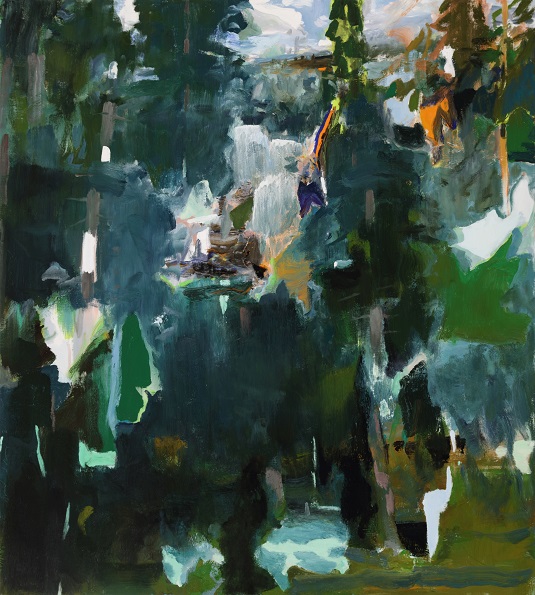
"Source" by Eric Aho, 2018. Oil on linen, 78 x 70 inches. Courtesy of the artist and DC Moore Gallery, New York.
.
Several of the larger canvases, notably River Guide, Road and Guide are bound at the bottom edge by a horizontal band identified in the title as either a road or a river, elements traditionally used in landscape painting on the diagonal to assist the mind’s eye into the painting’s deeper space. Aho’s use of a road that echoes the lower frame recalls Cezanne’s use of horizontal elements as visual barriers meant to focus the viewer’s attention on the structure of his composition.
.
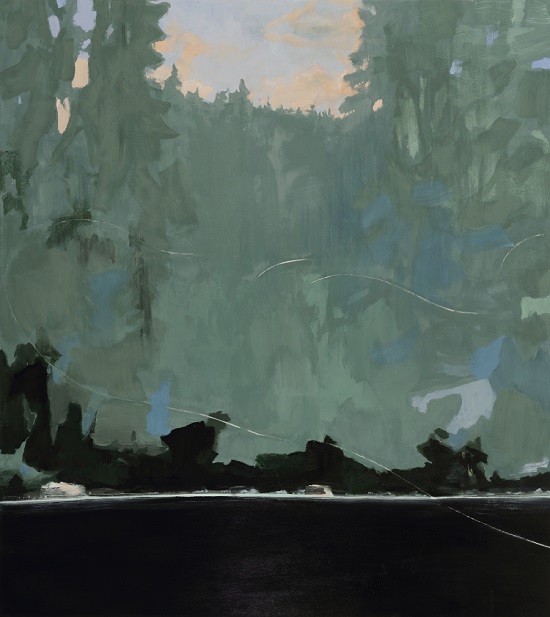
"River Guide" by Eric Aho, 2018. Oil on linen, 90 x 80 inches. Courtesy of the artist and DC Moore Gallery, New York.
.
However, unlike the analytical Cezanne, Aho’s barriers seem emotional. Suggestions of extreme elevations commingle nature’s majesty with a sense of dread, a dread reminiscent of the dualistic charm that haunts fairytales. To be sure, there is no melodrama here. But Aho’s depiction of nature as something partially seen lends a vaguely menacing tone, both to the scale of the larger canvases and to the confusion of the smaller ones.
And yet for all their foreboding and strangeness, Aho’s canvases remain appealing. Perhaps they are meant as an expression of the lure nature dangles before us. Pinewood Nocturne No. 1 is an especially unsettling picture. Smoky grey blotches appear lit from below by indecipherable white forms near the bottom of the frame. Its suggestion of oncoming nocturnal darkness is certainly convincing. Still, Aho’s use of the word nocturne, which recalls Whistler’s lyrical harbor paintings, seems almost ironic.
.
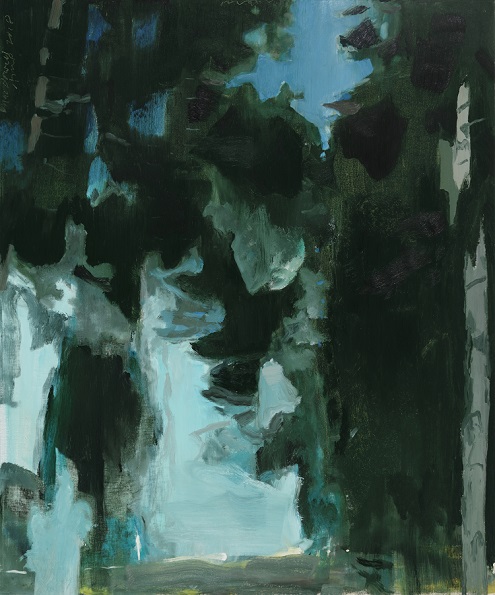
"Pinewood Nocturne no. 1" by Eric Aho, 2018. Oil on linen, 60 x 50 inches. Courtesy of the artist and DC Moore Gallery, New York.
.
Whistler’s paintings whispered a decipherable spatial order. Aho’s Pinewood is thoroughly disorienting. Knowledge of its landscape intention only amplifies its perplexing character. The light emitting from below negates any sense of the familiar. Its ghostly whiteness is very much the opposite of a welcoming campfire.
The reduction of complex imagery to abstract form is the essence of Aho’s paintings. But unlike the abstracted landscapes David Hockney showed a while back at Pace, these pictures are not built of joyously gathered minutiae. Aho’s larger compositions brood like Clifford Still’s jagged curtains, his forest interiors evolve mysteriously from secret articulations like those found in Arshile Gorky’s gardens and domestic mysteries. Their unsettling characteristics and lack of sentimentality are their strongest asset.
In the painting Guide, an odd whiplash of an angler’s line dances across the canvas with no sign of the individual at the reel end. It seems to suggest a fleeting human presence: a mere trace of what Aho’s version of nature might consider an insignificant intrusion.
______________________
BASIC FACTS: “Eric Aho: Guide” is extended and remains on view through November 24, 2018 at DC Moore Gallery, 535 West 22nd Street, New York, NY 10011. www.dcmooregallery.com.
_______________________
Copyright 2018 Hamptons Art Hub LLC. All rights reserved.
